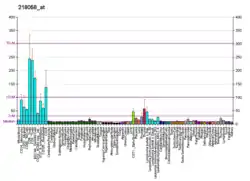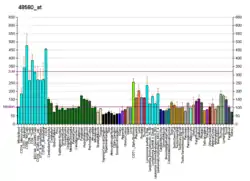CXXC1
CpG-binding protein (CGBP) also known as CXXC-type zinc finger protein 1 (CXXC1) or PHD finger and CXXC domain-containing protein 1 (PCCX1) is a protein that in humans is encoded by the CXXC1 gene.[5][6][7]
Proteins that contain a CXXC motif within their DNA-binding domain, such as CXXC1, recognize CpG sequences and regulate gene expression.[6]
References
- GRCh38: Ensembl release 89: ENSG00000154832 - Ensembl, May 2017
- GRCm38: Ensembl release 89: ENSMUSG00000024560 - Ensembl, May 2017
- "Human PubMed Reference:". National Center for Biotechnology Information, U.S. National Library of Medicine.
- "Mouse PubMed Reference:". National Center for Biotechnology Information, U.S. National Library of Medicine.
- Fujino T, Hasegawa M, Shibata S, Kishimoto T, Imai S, Takano T (Jun 2000). "PCCX1, a novel DNA-binding protein with PHD finger and CXXC domain, is regulated by proteolysis". Biochem Biophys Res Commun. 271 (2): 305–310. doi:10.1006/bbrc.2000.2614. PMID 10799292.
- Voo KS, Carlone DL, Jacobsen BM, Flodin A, Skalnik DG (Mar 2000). "Cloning of a mammalian transcriptional activator that binds unmethylated CpG motifs and shares a CXXC domain with DNA methyltransferase, human trithorax, and methyl-CpG binding domain protein 1". Mol Cell Biol. 20 (6): 2108–2121. doi:10.1128/MCB.20.6.2108-2121.2000. PMC 110827. PMID 10688657.
- "Entrez Gene: CXXC1 CXXC finger 1 (PHD domain)".
External links
- Human CXXC1 genome location and CXXC1 gene details page in the UCSC Genome Browser.
- Human SPP1 genome location and SPP1 gene details page in the UCSC Genome Browser.
- Overview of all the structural information available in the PDB for UniProt: Q9P0U4 (CXXC-type zinc finger protein 1) at the PDBe-KB.
Further reading
- Wiemann S, Weil B, Wellenreuther R, et al. (2001). "Toward a catalog of human genes and proteins: sequencing and analysis of 500 novel complete protein coding human cDNAs". Genome Res. 11 (3): 422–435. doi:10.1101/gr.GR1547R. PMC 311072. PMID 11230166.
- Simpson JC, Wellenreuther R, Poustka A, et al. (2001). "Systematic subcellular localization of novel proteins identified by large-scale cDNA sequencing". EMBO Rep. 1 (3): 287–292. doi:10.1093/embo-reports/kvd058. PMC 1083732. PMID 11256614.
- Lee JH, Voo KS, Skalnik DG (2002). "Identification and characterization of the DNA binding domain of CpG-binding protein". J. Biol. Chem. 276 (48): 44669–44676. doi:10.1074/jbc.M107179200. PMID 11572867.
- Carlone DL, Skalnik DG (2001). "CpG binding protein is crucial for early embryonic development". Mol. Cell. Biol. 21 (22): 7601–7606. doi:10.1128/MCB.21.22.7601-7606.2001. PMC 99931. PMID 11604496.
- Lee JH, Skalnik DG (2003). "CpG-binding protein is a nuclear matrix- and euchromatin-associated protein localized to nuclear speckles containing human trithorax. Identification of nuclear matrix targeting signals". J. Biol. Chem. 277 (44): 42259–42267. doi:10.1074/jbc.M205054200. PMID 12200428.
- Strausberg RL, Feingold EA, Grouse LH, et al. (2003). "Generation and initial analysis of more than 15,000 full-length human and mouse cDNA sequences". Proc. Natl. Acad. Sci. U.S.A. 99 (26): 16899–16903. doi:10.1073/pnas.242603899. PMC 139241. PMID 12477932.
- Gerhard DS, Wagner L, Feingold EA, et al. (2004). "The status, quality, and expansion of the NIH full-length cDNA project: the Mammalian Gene Collection (MGC)". Genome Res. 14 (10B): 2121–2127. doi:10.1101/gr.2596504. PMC 528928. PMID 15489334.
- Barrios-Rodiles M, Brown KR, Ozdamar B, et al. (2005). "High-throughput mapping of a dynamic signaling network in mammalian cells". Science. 307 (5715): 1621–1625. doi:10.1126/science.1105776. PMID 15761153. S2CID 39457788.
- Lee JH, Skalnik DG (2006). "CpG-binding protein (CXXC finger protein 1) is a component of the mammalian Set1 histone H3-Lys4 methyltransferase complex, the analogue of the yeast Set1/COMPASS complex". J. Biol. Chem. 280 (50): 41725–41731. doi:10.1074/jbc.M508312200. PMID 16253997.
- Lim J, Hao T, Shaw C, et al. (2006). "A protein-protein interaction network for human inherited ataxias and disorders of Purkinje cell degeneration". Cell. 125 (4): 801–814. doi:10.1016/j.cell.2006.03.032. PMID 16713569. S2CID 13709685.
- Young SR, Skalnik DG (2007). "CXXC finger protein 1 is required for normal proliferation and differentiation of the PLB-985 myeloid cell line". DNA Cell Biol. 26 (2): 80–90. doi:10.1089/dna.2006.0535. PMID 17328666.
This article is issued from Wikipedia. The text is licensed under Creative Commons - Attribution - Sharealike. Additional terms may apply for the media files.





